

Aboriginal heritage Ku-ring-gai. The Darramuragal people The Darramuragal or Darug people have been in this area for thousands of years, long before the arrival of European settlers.
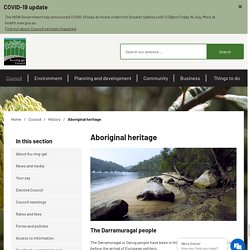
Living mostly along the foreshores of the harbour, they fished and hunted in the waters and harvested food from the surrounding bushland. Aboriginal Heritage Walk - Ku-ring-gai Chase National Park. Australia Over Time: National Parks - Our History. Australia’s national parks websites. <p>Please <a href=" javascript</a> to access the full functionality of this site</p> For 12 July 2021: Visitors to NSW national parks must check the latest NSW Government COVID-19 updates for advice on current required safety measures.
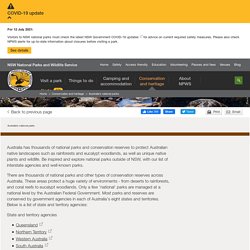
Please also check NPWS alerts for up-to-date information about closures before visiting a park. See details. National Parks in Australia. UNESCO World Heritage - Australia. First national park - National Museum of Australia. The dislocations caused by the discovery of gold, the burgeoning numbers of new arrivals seeking better lives and the chronic shortage of housing led to a wide range of social ills, not least of which were overcrowding and the abandonment of children.
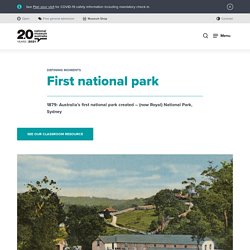
A variety of epidemics, but especially the scarlet fever outbreak in the 1870s, focused attention on public health. Those who advocated the value of parks (including cultivated gardens as well as areas of scenic beauty and splendour) increasingly claimed that urban areas, with their polluted air and water, were detrimental to people’s physical and moral health. The creation of national parks was one expression of the relatively new idea that nature could be beneficial, rather than a threat. Park advocates were expressing ideas first articulated by the Romantics (that coterie of painters, writers and poets, such as Wordsworth) who in the early years of the Industrial Revolution praised ‘natural’ England and damned its cities. Bobbin Head Walks, Playgrounds and Cafes in Ku-Ring-Gai National Park. Located in the west of Ku-ring-gai Chase National Park (NSW), Bobbin Head is a large area offering lots of things to do.
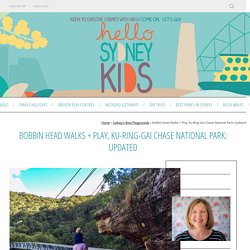
From bushwalks to water sports, or simply relax enjoying the beautiful water views, Bobbin Head ticks all the boxes. Besides the natural attractions, Bobbin Head has great facilities such as picnic grounds with shelters and barbecues, several cafés, a small playground and spacious grassy areas for the kids to run and play ball games. Dictionary of Sydney - Bobbin Head. Lessons in Nature - Bobbin Head - Features of Places. Lessons in Nature - Local Aboriginal Sites at Bobbin Head. These learning activities meet both the Geography and History syllabus content as well as the cross curricula priority area of Aboriginal Histories and Cultures.
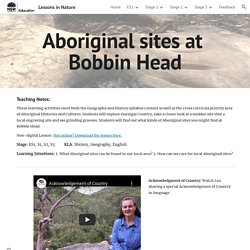
Students will explore Guringai Country, take a closer look at a midden site visit a local engraving site and see grinding grooves. Students will find out what kinds of Aboriginal sites you might find at Bobbin Head. Non-digital Lesson: Not online? Download the lesson here.
The Great Barrier Reef. Kakadu National Park. Booderee National Park. Christmas Island. Uluru-Kata Tjuta National Park. The Great Ocean Road. The Blue Mountains. The Eyre Peninsula. How do native Australian animals survive Australia's harsh environment? - Curtin University. Adaptations - The effects of heat - Centennial Parklands. 1.
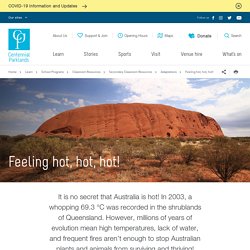
Is there evidence of the arid zone at your school? Survey for arid and fire adapted plants in your school. Click here to access the 'Plant Adaptations in your School' activity sheet. 10 weird and wonderful wildlife of Australia. Over 80 years ago the last Thylacine sadly died at Hobart Zoo.
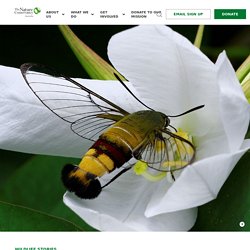
It earned its more common name at the time, Tasmanian Tiger, because of the distinctive tiger-like stripes along its lower back and tail. In fact, this was no tiger or Tasmanian Wolf, as it was also known, but a marsupial and therefore not closely related to cats or dogs at all. It had the characteristic pouch of other Australian national treasures such as the wombat, koala and kangaroo. Top 10 ingenious Aussie animal adaptations. Adaptation to climate - Planet doc. Animal Adaptations. Living Learning - Primary School Resources - plant adaptations - The Royal Botanic Garden Sydney.
List of Desert Australian Flora Plants. The Great Victoria, Great Sandy, Gibson and Simpson deserts are all part of the vast, arid landscape that dominates central and southwestern Australia.
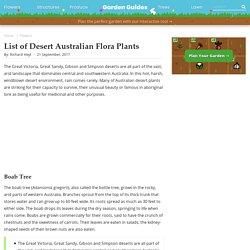
In this hot, harsh, windblown desert environment, rain comes rarely. Many of Australian desert plants are striking for their capacity to survive, their unusual beauty or famous in aboriginal lore as being useful for medicinal and other purposes. Boab Tree. Australian native plant nursery - Plant list — Australian Outback Plants - Native Plant Nursery - USA. The peak of cold resistance - Remember The Wild. Antarctic animal adaptations, penguins, seals, krill, whales. Emperor penguinAptenodytes forsteriaa Largest of all penguins by a considerable margin.
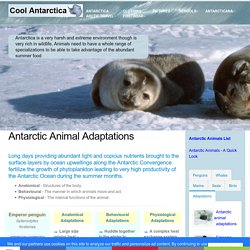
Animals of the very deep south and the only large animal that remains in Antarctica in the depths of the long dark winter night. More about emperor penguin adaptations Anatomical Adaptations. Plants and microbes – Australian Antarctic Program. Antarctica and the sub-Antarctic are home to a variety of plants and microbes.

These include lichens, mosses and liverworts, algae, kelp and microscopic organisms. Challenging conditions 98% of Antarctica's continental land mass is covered by ice up to 4.7 km thick. It is also the driest continent on earth. Most precipitation falls as snow. Primary Programs - Survive and Thrive - The Royal Botanic Garden Sydney. Plant Adaptations - Fact Sheets - Gardening Australia - GARDENING AUSTRALIA. SERIES 19 | Episode 15 By definition a Botanic Garden has a variety of plants. But what is it that drives the marvellous variation in the plant world - the answer is adaptation. Plants change their character, or adapt so they can survive in the wild.
But understanding about plant adaptations can also guide gardeners in the care and maintenance of our own plants. All About Plant Adaptation. Animal and plant adaptations - ABC Education. What makes an organism suited to a particular environment? View a range of animals and plants to investigate adaptations that improve their chance of survival. Link the adaptation which might be an external structure, an internal structure or an exhibited behaviour to its function (purpose). Adaptations: fire ecology - Kings Park and Botanic Garden.
National Geographic Society. Any number of characteristics can vary among individuals of a given species — some may be larger, hairier, fight off infections better, or have smaller ears. These characteristics are largely determined by their genes, which are passed down from their parents and subsequently passed down to their own offspring. Some of these characteristics, or traits, provide competitive advantages like speed, strength, or attractiveness. If those traits are particularly helpful, individuals with those traits will produce more offspring than those without. Over generations, the number of individuals with that advantageous trait, or adaptation, will increase until it becomes a general attribute of the species. Animals and Plants - Alice Springs Desert Park. Extreme adaptations in plants and animals - Royal Botanic Gardens.
5 human impacts on the environment - Khan academy. His Epic Message Will Make You Want to Save the World. Rhomaleosaurus: Back to Life in Virtual Reality #PreviouslyOnEarth. Australia's Nature Laws Failing Our Wildlife - WWF-Australia. Gould's mouse was declared extinct, but DNA shows it still lives on an island in Shark Bay, Western Australia. Before European settlers set foot on Australian shores, Gould's mouse scurried about the continent. But land clearing and the introduction of predators decimated native rodent populations, and the little mouse was declared extinct more than a century ago – until now.
Key points: Australia has the highest mammal extinction rate in the worldGould's mouse was thought to be extinct, but it is actually alive on an island off Western Australia, where it is known as the Shark Bay mouseScientists say the species should be a conservation priority to ensure the last population doesn't die out A team of researchers, led by Emily Roycroft of the Australian National University, looked at genomes of Australia's extinct and living rodents. Their analysis shows a small population of Gould's mouse (Pseudomys gouldii) lives on an island off the coast of Western Australia. Mexico abandons fishing-free zone for rare endangered porpoise. The Mexican government officially abandoned the policy of maintaining a fishing-free zone around the last 10 or so remaining vaquita marina — a critically endangered porpoise.
The measure announced Wednesday replaces the fishing-free “zero tolerance” zone in the upper Gulf of California with a sliding scale of punishments if more than 60 boats are seen in the area on multiple occasions. Given that Mexico has been unable to enforce the current restrictions — which bans boats in the small area — the sliding-scale punishments also seem doomed to irrelevance. Environmental experts say the move essentially abandons the world’s most endangered marine mammal to the gill nets that trap and drown them.
The nets are set for totoaba, a fish whose swim bladder is a delicacy in China, and sells for thousands of dollars per kilogram. Human Impacts on Antarctica and Threats to the Environment, scientific bases, tourists and tourism, fishing and fisheries, mining, oil exploration, and other potential perils. Kakadu guide to threatened species lr final. 17 national parks you can now take online virtual tours to. The Hidden Worlds of the National Parks.